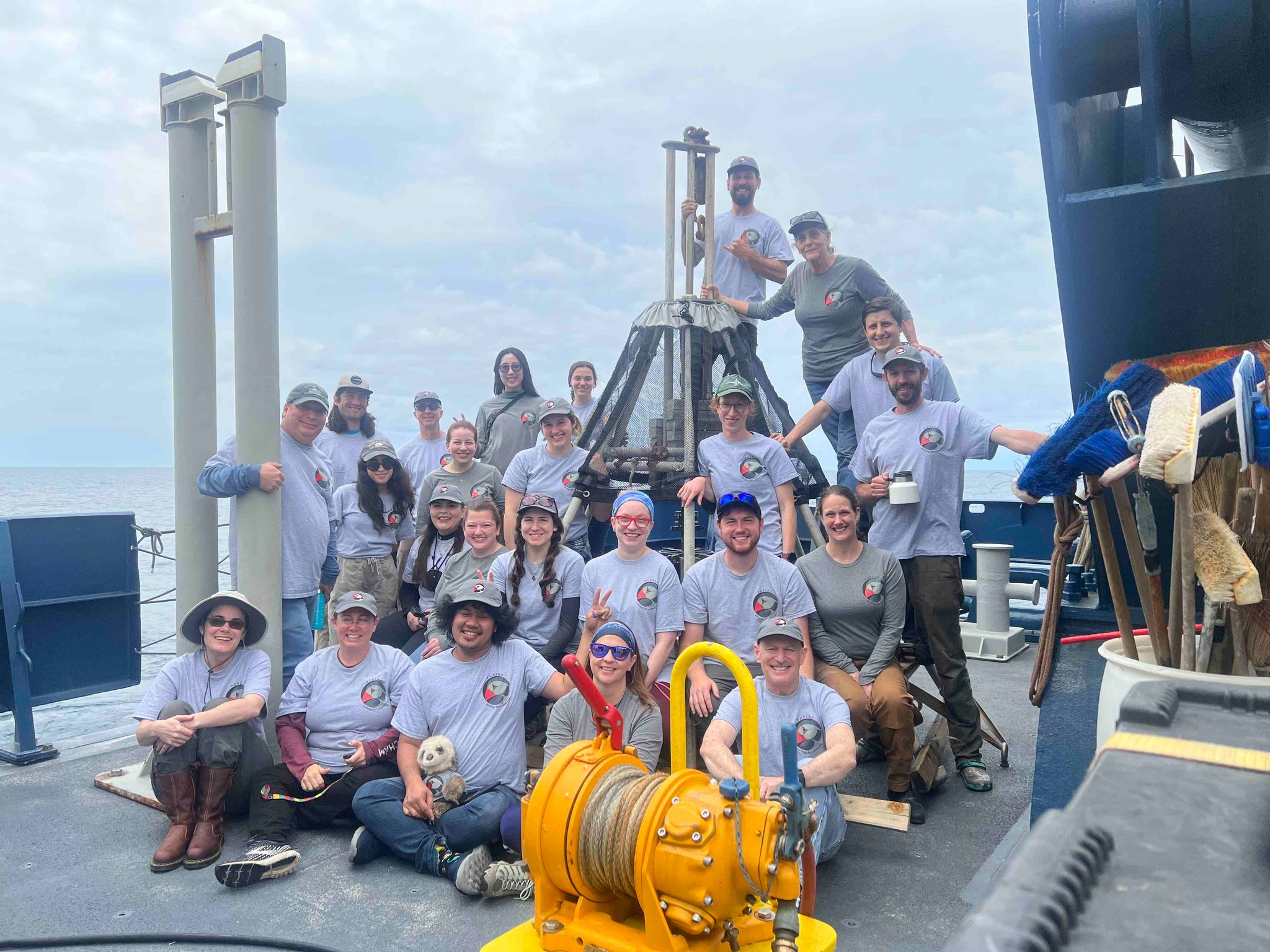Project Summary
To summarize many weeks of work most succinctly, our June voyage aboard the R/V Atlantis was a success. We were able to recover the desired cores of deep-sea sediment from areas off the coast of Nova Scotia and New Jersey. I helped out with most aspects of this project – retrieving and sectioning gravity and piston cores, retrieving and sectioning multicores, and describing the collected mud samples. These cores will be analyzed in labs at Woods Hole Oceanographic Institute, Rutgers University, and the University of Washington over the next year. One of the main research goals is to use the alkenone paleothermometer to reconstruct sea surface temperature over the past 10,000 years. More specifically, this data will help to resolve the Holocene Conundrum – the odd mismatch between land-, sea-, and climate model-based estimates of global near-surface temperature during the Holocene, prior to the common era (10,000 – 2000 ya). I plan to follow the data analysis process over the next year and hope to visit Rutgers University next summer to review the initial results of the project, tour the laboratories, and visit the Rutgers Geology Museum.

Practical Applications
So much of the work I conducted on the ship is directly applicable to my teaching. Below is a comprehensive list of different topics and how they relate.
- Core Analysis – In my Earth science class, we use cross-sections to interpret the geologic history of different areas. The sections we use are either 1) drawn out on paper or 2) present naturally in the field (via road cut or stream cut). The same techniques we learn in class can be applied to the analysis of the cores of mud we collected aboard the R/V Atlantis.
- Paleothermometry – We study a variety of different methods by which scientists learn about the climate of the past in my Earth science class. Up to this point, however, we have solely discussed carbon and oxygen isotope ratios. The alkenone paleothermometer represents a unique temperature proxy that will broaden the scope of this unit and expose students to a completely different avenue of research in the field.
- Alkenone Chemistry – Alkenones are organic molecules and represent a interesting case study for my organic chemistry class. A large portion of this class involves learning different organic functional groups and how they behave chemically. Alkenes are ketones that contain double bonds (alkenes) within their side-chains. Notably, alkenone-producing species respond to changes in water temperature by varying the degrees of unsaturation (number of pi bonds) in the alkenones they produce. The alkenone paleothermometer represents a beautiful connection between organic chemistry, biology, and geology – scientists can use the distribution of alkenones present in marine sediment to reconstruct sea surface temperatures of the past.
- Solid-Liquid Extraction – Alkenones are extracted from sediment layers of interest using sonnication-based solid-liquid extraction, typically with a 9:1 methanol / methylene chloride liquid phase. We use this same technique in the organic chemistry laboratory.
- Gas Chromatography – Alkenone extract is injected into a gas chromatograph, which allows for analysis of the different types of alkenones present in the extract. We use this same technique in the organic chemistry laboratory.
- Experimental Design – The design of this research project was very complex, with many different things going on concurrently. Participating constituted a great learning experience for me in terms of understanding effective experimental design and observing how a complex project is actually carried out on a ship.
- Careers in Field Science – My experience exposed me to a wide variety of careers and summer work opportunities in field science. I can now share these opportunities with my students to engage them in the classroom and give them different options for future pursuit.

Reflection
This voyage represented my first formal geology field research experience, and I am so grateful to have been a part of it. The highlights of my field experience were the people. I am very thankful to the entire PUFINS crew for taking time out of their busy days to help me learn the different research techniques, answer my many questions, and participate in my outreach efforts. I worked the night shift with Dr. Amy Wagner, Ryan Glaubke, Tiffany Audet, Estelle Allan, Hope Sisley, and Batoul Saad, and I couldn’t have asked for a better team. I’m very grateful for Ryan’s seemingly endless supply of good tunes that helped the time fly during multicore sectioning and for Dr. Wagner’s insistence on a break every day to watch the sunrise. Everyone on the shift was at a different point in their education and/or career, and it was so great to learn about their unique educational paths, research interests, and aspirations. I also enjoyed meeting those on the ship working in non-science roles; the ship truly felt like a living organism, with everyone working together synergistically to ensure success in data collection.

Keeping up with my journaling requirements was definitely challenging, but everyone was quite supportive of my efforts. I definitely got the feeling that my work was needed and appreciated. My students very much enjoyed the livestreams, especially when others on the ship participated. I believe this was a unique and effective way of engaging my students during their summer vacations.
I must extend my sincere thanks to the below individuals who made this excellent professional development program possible.
- Dr. Lauren Neitzke Adamo – Chief Outreach Officer
- Dr. Liz Sikes – Chief Scientist
- Dr. Julian Sachs – Principal Investigator
- Ria Sarkar – Outreach Officer
- Dr. Natalie Umling – Watch Leader
- Dr. Amy Wagner – Watch Leader
Thanks also to my fellow onboard educators – Stacey Sebert, Alé Martinez, and Erin Sharpe. It was so great to work with you and learn from you. I look forward to networking over the coming school year as we work to create classroom activities based on this research.

